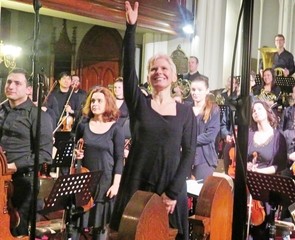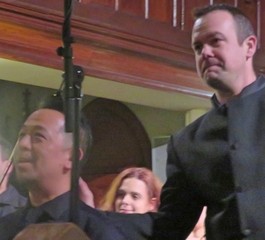|
Back
Sibelius in the Jungle New York
St. Pauls German Evangelical Lutheran Church
01/26/2019 -
Aaron Dai: Four Miniatures for a Dark Age
Carl Nielsen: Concerto For Clarinet and Orchestra
Jean Sibelius: Symphony No. 2 in D Major, Opus 43
Kim Lewis (Flute), Sarah Koop McCoy (Clarinet), Béa Naumann (Violin)
Chelsea Symphony, Matthew Aubin, Nell Flanders (Conductors)

N. Flanders, Chelsea Symphony (© Samuel A. Dog)
“I love the vast surface of silence, and my chief delight is breaking it.”
Carl Nielsen (1865-1931)
After Alan Gilbert’s extraordinary Carl Nielsen “festival” with the New York Philharmonic four years ago, one could hardly believe that another work by the singular Danish composer would cut any musical ice. That, though, was not reckoning with one of New York’s great musical hidden joys, the Chelsea Symphony.
For over 13 years, the Chelsea Symphony’s 30-plus artists have given countless premieres, have essayed music far “larger” than their resources (like last night’s Sibelius symphony) have encouraged young composers and young artists, and given international performances.
Even their own participation in Mozart in the Jungle only signaled that New York is an orchestra jungle, and one sometimes must ignominiously dismiss provincial areas like “Chelsea” for behemoths like Philharmonic and Vienna and Berlin.
This was confessedly my first visit, and it was mainly to hear the Clarinet Concerto. Unlike his eccentric and marvelous symphonies, Nielsen pulled the trick of giving it a chamber orchestra–with a couple of bassoons and his inevitable snare-drum. Thus, the ensemble was made for the Chelsea Orchestra, whose volume in the church was almost too heavy for the soloist.
That was irrelevant. This is a work where soloist Sarah Koop McCoy and the dynamic conductor Matthew Aubin let loose with this disjointed yet ravishingly beautiful work. Ms. McCoy was never one to “rhapsodize” the piece. It is, after all, not only incredibly difficult, but its moods are impetuous and mercurial.
Ms. McCoy started with a muscular opening, vying with Mr. Aubin’s chamber group, yet within hardly a minute–after Scott Still’s snare-drum tattoos–with a breathless cadenza. It was faultless, her breath control was to be envied (from this one-time licorice player), and one was in for a romping non-structural party.
Like that other singular genius, Charles Ives, Nielsen was son of a bandmaster (his father’s trumpet is on the wall of his birthplace, I remember), so he knew his winds well, giving Ms. McCoy time to clean out the instrument before returning to the party. The energy, the virility was never lacking. But toward the end, one heard Nielsen’s attention to a flowing almost romantic truce between instruments. And while the sounds could be harsh, upsetting, happily disconcerting, the final hush was like the Amen to a raucous clarinet gloria/hosannah.
Like Mozart, Nielsen saved this masterpiece for the end of his life, and one thinks that Mozart would have loved the series of unexpected turns, the use of his favorite instrument, and Ms. McCoy’s artistry in the blasts on high and the undertows at the end.

A. Dai, M. Aubin (© Samuel A. Dog)
The evening began with a title of moribund significance. Aaron Dai’s Four Miniatures for a Dark Age. Yes, they were indeed tiny in duration, but were as complex in orchestration as some of Webern’s bagatelles. (Without, thank heaven, the serial rules and regulations.)
We had string flurries at the start, more strings, more unfinished fluidity for a second movement, and a roaring but unfinished series of cadences for the end. Il Buffone, the third movement, was made for tuba player Ben Vokits, who had to fight to finish his solo. Still, nothing was doleful for these “dark ages”. Mr. Dai produced just enough music to show that tragedy can be fun.
The podium was taken over by Nell Flanders who conducted a pleasant Sibelius Second. In Asia many years ago, I heard the Helsinki City Orchestra give a series of Sibelius symphonies which were totally different than the usual monster-orchestra performances. The music was transparent, easy-going, yes, provincial. For good or evil, memorable.
Ms. Flanders took her 30-plus players through their paces with rare fluffs. Her exaggerated pauses were interesting but the Chelsea Orchestra didn’t have the pinpoint entrances to give them power.
Still, one can never resist that radiant minor-to-major climax, and even the abbreviated forces here possessed both expertise and that essential volition for a most majestic end.
Harry Rolnick
|